About compatibility
We briefly will describe different compatibility possibilities.
Our compatibility is determined on the reaction of our brain.
Case 1. Indifference to partner.
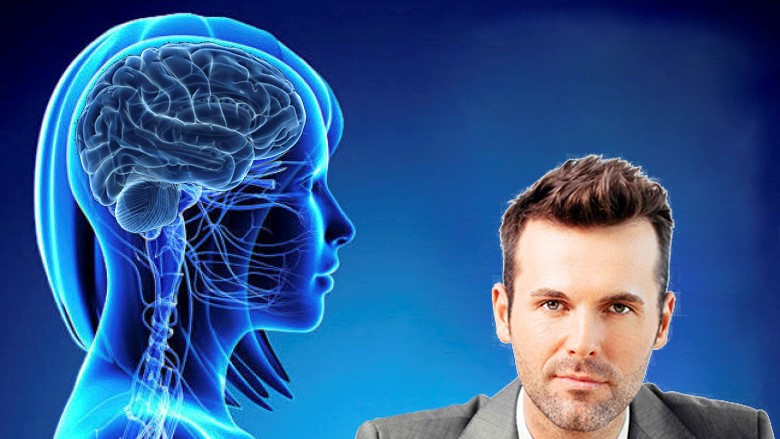
Our body and brain is not reacting on visual image of a person, his voice, touch, smell.
In our chart the columns are low in this case ( below approx 20 percent)
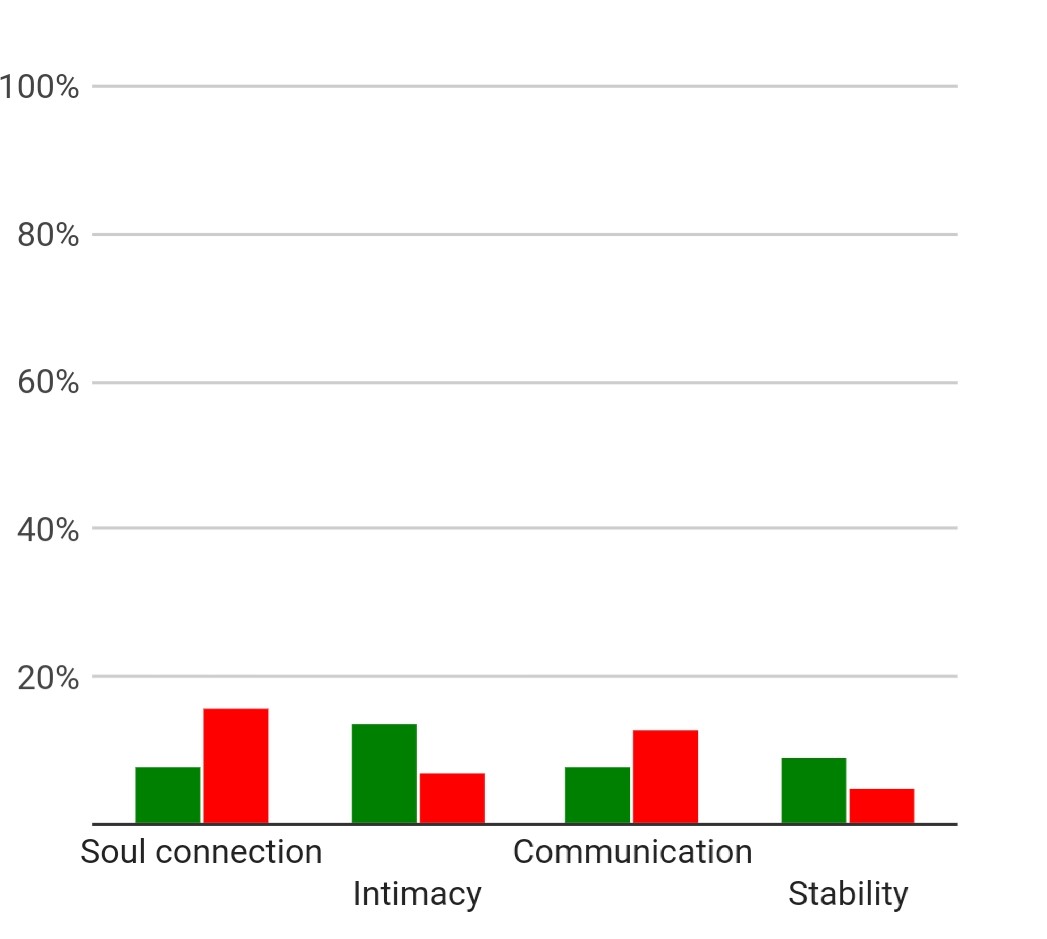
Case 2. Very active interest.
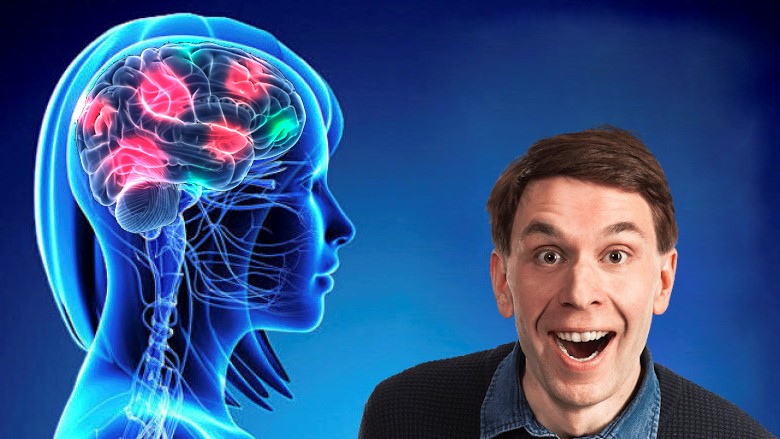
Our body and brain reacts very strongly on other person. In our compatibility charts this is shown in RED colors above approx 20 percent.
This can be interesting in short term, but on long term it will be too overstimulating or irritating.
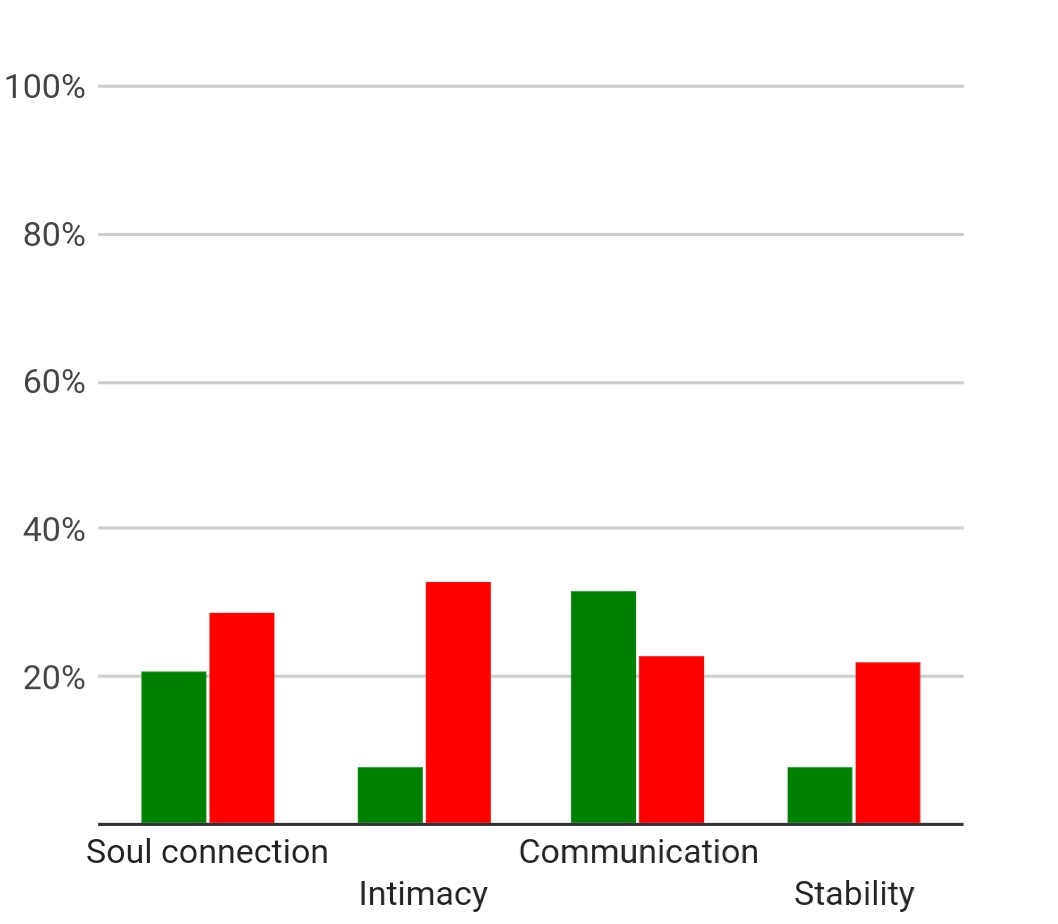
Case 3. Harmonious interest.
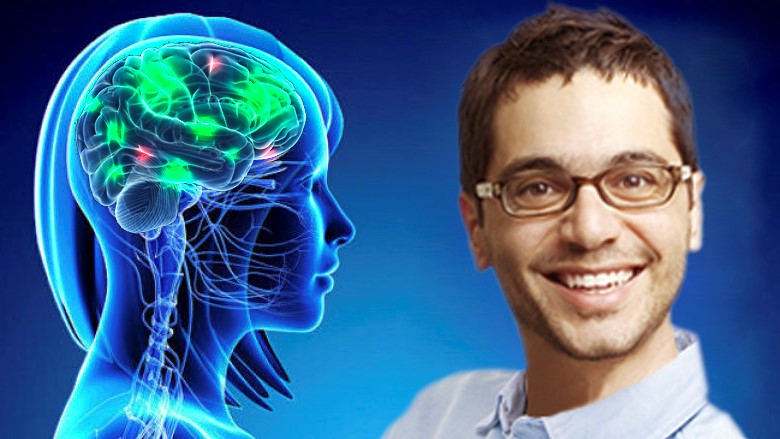
Our body and brain reacts very smoothly on a person. From the beginning this reaction even will be not felt. But with time people will feel more and more comfortable with each other. This is shown on our charts as GREEN color above approx 20 percent.
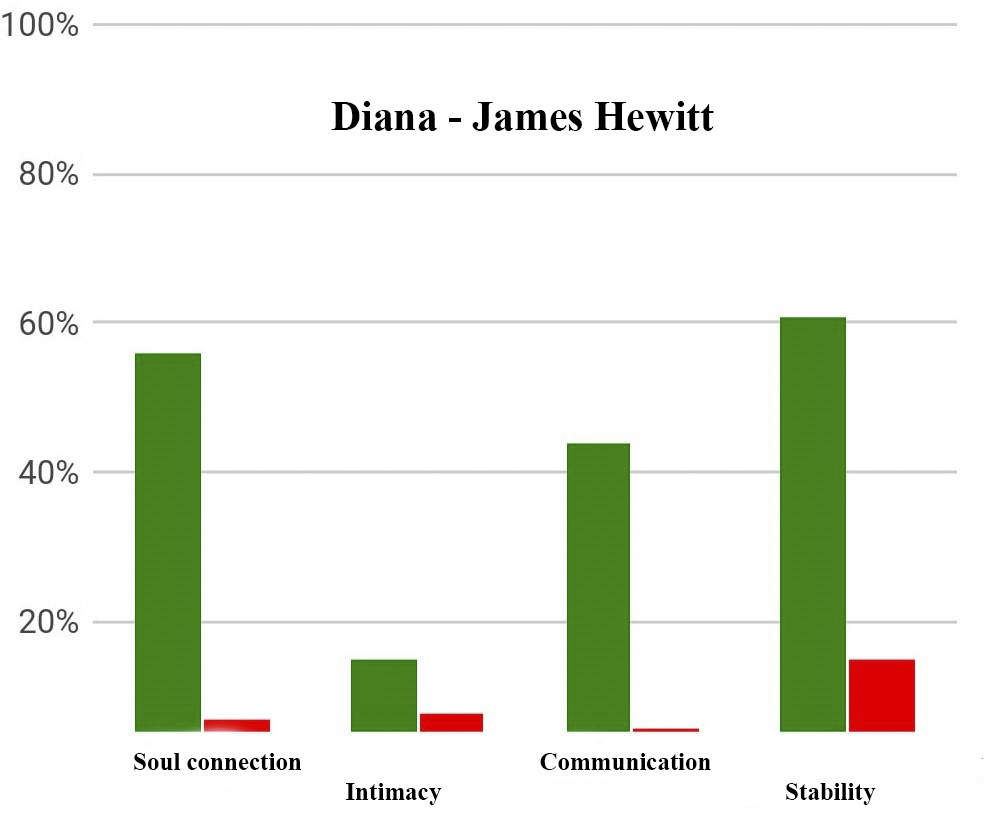
WHAT DOES THE RED REPRESENT ON THE GRAPHS?
Red in SOUL means that people will feel that they are different.
Red in INTIMACY means that people will feel a strong passion for each other. Such a passion initially attracts, then can develop into irritability.
Red in COMMUNICATION means that people will have different points of view on life and it will be difficult for them to agree. In family life, this does not interfere, but in business it can very much interfere.
Red in STABILITY means that people will unnecessarily restrict each other's freedom. At the beginning of the relationship, this restriction may not be felt, but it will increase over time.
Red in CREATIVITY (for all charts except romantic ones) means that people will conflict in creative interaction. Sometimes such a conflict can produce interesting results, but in general it is not comfortable.
If red and green exist at the same time in the chart this means that part time one of the energies will manifest, and part time another.
It is also good to have some active interest ( RED color on chart). Otherwise people can start feel too sleepy with each other. From 10 till 20 percent red will not make you life difficult. Read above 30 percent starts to be difficult. Below you can see a good proportion.
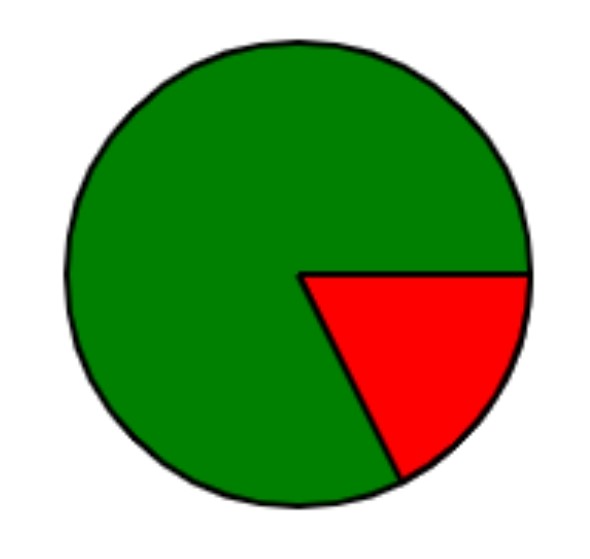
Our charts and research are based on following articles:
- Lee WS, Mckinnish T. The marital satisfaction of differently aged couples. J Popul Econ. 2018;31(2):337-362. doi:10.1007/s00148-017-0658-8
- Antfolk J, Salo B, Alanko K, Bergen E, Corander J, Sandnabba N and Santtila P. (2015). Women’s and Men’s Sexual Preferences and Activities with Respect to the Partner’s Age: Evidence for Female Choice. Evolution and Human Behavior, 36: 73–79. [Google Scholar]
- Amato P, Booth A, Johnson D and Rogers S. (2007). Alone Together: How Marriage in America is Changing. Cambridge, MA: Harvard University Press. [Google Scholar]
- Becker G, Landes E and Michael R. (1977). An Economic Analysis of Marital Instability. Journal of Political Economy, 85: 1141–87. [Google Scholar]
- Belot M and Francesconi M. (2013). Dating Preferences and Meeting Opportunities in Mate Choice Decisions. Journal of Human Resources, vol. 48: 474–508. [Google Scholar]
- Bergstrom T and Bagnoli M. (1993). Courtship as a Waiting Game, Journal of Political Economy, 101: 185–201. [Google Scholar]
- Cherlin. A (1977). . Demography >span class="ref-vol">14(3): 265–272. [PubMed] [Google Scholar]
- Choo Eugene, and Siow Aloysius. 2006. “Who Marries Whom and Why.” Journal of Political Economy 114 (1): 175–201. [Google Scholar]
- Coles M and Francesconi M. (2011). On the Emergence of Toyboys: the Timing of Marriage with Aging and Uncertain Careers. International Economic Review, 52: 825–853. [Google Scholar]
- Diaz-Gimenez J and Giolito E. (2013). Accounting for the Timing of First Marriage. International Economic Review, 54: 135–158. [Google Scholar]
- Drefahl S (2010). How does the Age Gap Between Partners Affect their Survival? Demography, 47: 313–326. [PMC free article] [PubMed] [Google Scholar]
- Ferrer-i-Carbonell A and Frijters P. (2004). How Important is Methodology for the Estimates of the Determinates of Happiness? The Economic Journal, 114(497):641–59. [Google Scholar]
- Fisman R, Iyengar S, Kamenica E and Simonson I. (2006). Gender Differences in Mate Selection: Evidence from a Speed Dating Experiment. The Quarterly Journal of Economics, 121(2): 673–697. [Google Scholar]
- Glenn N (1998). . Journal of Marriage and Family, >span class="ref-vol">60: 569–576. [Google Scholar]
- Glick P and Lin S-L. (1986). Recent Changes in Divorce and Remarriage. Journal of Marriage and Family, 48: 737–747. [Google Scholar]
- Groot W and Van Den Brink H. (2002). Age and Education Differences in Marriages and their Effects on Life Satisfaction. Journal of Happiness Studies, 3: 153–165. [Google Scholar]
- Hitsch G, Hortascsu A and Ariely D. (2010). Matching and Sorting in Online Dating. American Economic Review, 100(1): 130–163. [Google Scholar]
- Lillard L, Brien M and Waite L. (1995). Premarital Cohabitation and Subsequent Marital Dissolution: A Matter of Self Selection. Demography, 32(3):437–57. [PubMed] [Google Scholar]
- Mansour H and McKinnish T. (2014). Who Marries Differently Aged Spouses? Ability, Education, Occupation, Earnings, and Appearance. Review of Economics and Statistics, 96: 577–580. [Google Scholar]
- Meng X and Gregory RG (2005). Intermarriage and Economic Assimilation of Immigrants, Journal of Labor Economics, 23: 135–176. [Google Scholar]
- Presser H (1975). Age Differences between Spouses, American Behavioral Scientist, 19: 190–205. [Google Scholar]
- Rogler L and Procidano M. (1989). Marital Heterogamy and Marital Quality in Puerto Rican Families, Journal of Marriage and Family, 51: 363–372. [Google Scholar]
- Sanderson E and Windmeijer F (2016). A Weak Instrument F-test in Linear IV Models with Multiple Endogenous Variables. Journal of Econometrics, 190: 212–221. [PMC free article] [PubMed] [Google Scholar]
- Siow A (1998). Differential Fecundity, Markets, and Gender Roles. Journal of Political Economy, 106: 334–354. [Google Scholar]
- Van Poppel F, Liefbroer A, Vermunt J and Smeenk W. (2001). Love, Necessity and Opportunity: Changing Patterns of Marital Age Homogamy in the Netherlands, 1850–1993. Population Studies, 55: 1–13. [Google Scholar]
- Van De Putte B, Van Poppel F, Vanassche S et al. (2009). . Journal of Marriage and Family, >span class="ref-vol">47: 1234–1253. [Google Scholar]
- Van Laningham J, Johnson D and Amato P. (2001). Marital Happiness, Marital Duration, and the U-shaped Curve: Evidence from a Five-Wave Panel Study. Social Forces, 78: 1313–1341. [Google Scholar]
- Vera H, Berardo D and Berardo F. (1985). Age Heterogamy in Marriage. Journal of Marriage and Family, 47: 553–566. [Google Scholar]
- Weiss Y and Willis R. (1997). Match quality, New Information, and Marital Dissolution. Journal of Labor Economics, 15(1):S293–S329. [PubMed] [Google Scholar]
- Wood S (2006). Low-rank Scale-invariant Tensor Product Smooths for Generalized Additive Mixed Models. Biometrics, 62: 1025–1036. [PubMed] [Google Scholar]
- Zhang H, Ho P and Yip P. (2012). Does Similarity Breed Marital and Sexual Satisfaction? Journal of Sex Research, 49: 583–593. [PubMed] [Google Scholar]
____
Aertsen, A. M., Gerstein, G. L., Habib, M. K., and Palm, G. (1989). Dynamics of neuronal firing correlation: modulation of “effective connectivity”. J. Neurophysiol. 61, 900–917.
Aharon, I., Etcoff, N., Ariely, D., Chabris, C. F., O’Connor, E., and Breiter, H. C. (2001). Beautiful faces have variable reward value: fMRI and behavioral evidence. Neuron 32, 537–551. doi: 10.1016/S0896-6273(01)00491-3
Aragona, B. J., Liu, Y., Curtis, J. T., Stephan, F. K., and Wang, Z. (2003). A critical role for nucleus accumbens dopamine in partner-preference formation in male prairie voles. J. Neurosci. 23, 3483–3490.
Beauregard, M., Leroux, J.-M., Bergman, S., Arzoumanian, Y., Beaudoin, G., Bourgouin, P.,et al. (1998). The functional neuroanatomy of major depression: an fMRI study using an emotional activation paradigm. Neuroreport 9, 3253–3258. doi: 10.1097/00001756-199810050-00022
Botvinick, M. M., Cohen, J. D., and Carter, C. S. (2004). Conflict monitoring and anterior cingulate cortex: an update. Trends Cogn. Sci. (Regul. Ed.) 8, 539–546. doi: 10.1016/j.tics.2004.10.003
Breiter, H. C., Aharon, I., Kahneman, D., Dale, A., and Shizgal, P. (2001). Functional imaging of neural responses to expectancy and experience of monetary gains and losses. Neuron 30, 619–639. doi: 10.1016/S0896-6273(01)00303-8
Brunet, E., Sarfati, Y., Hardy-Baylé, M.-C., and Decety, J. (2000). A PET investigation of the attribution of intentions with a nonverbal task. Neuroimage 11, 157–166. doi: 10.1006/nimg.1999.0525
Buckner, R. L., Andrews-Hanna, J. R., and Schacter, D. L. (2008). The brain’s default network. Ann. N. Y. Acad. Sci. 1124, 1–38. doi: 10.1196/annals.1440.011
Bush, G., Frazier, J. A., Rauch, S. L., Seidman, L. J., Whalen, P. J., Jenike, M. A.,et al. (1999). Anterior cingulate cortex dysfunction in attention-deficit/hyperactivity disorder revealed by fMRI and the counting Stroop. Biol. Psychiatry 45, 1542–1552. doi: 10.1016/S0006-3223(99)00083-9
Buzsáki, G., and Draguhn, A. (2004). Neuronal oscillations in cortical networks. Science 304, 1926–1929. doi: 10.1126/science.1099745
Cabeza, R., and Nyberg, L. (2000). Neural bases of learning and memory: functional neuroimaging evidence. Curr. Opin. Neurol. 13, 415–421. doi: 10.1097/00019052-200008000-00008
Camara, E., Rodriguez-Fornells, A., Ye, Z., and Münte, T. F. (2009). Reward networks in the brain as captured by connectivity measures. Front. Neurosci. 3:350–362. doi: 10.3389/neuro.01.034.2009
Chou, Y.-H., Panych, L. P., Dickey, C. C., Petrella, J. R., and Chen, N.-K. (2012). Investigation of long-term reproducibility of intrinsic connectivity network mapping: a resting-state fMRI study. Am. J. Neuroradiol. 33, 833–838. doi: 10.3174/ajnr.A2894
Clark, M. S., and Mills, J. (1979). Interpersonal attraction in exchange and communal relationships. J. Pers. Soc. Psychol. 37, 12–24. doi: 10.1037/0022-3514.37.1.12
Cooper, J. C., and Knutson, B. (2008). Valence and salience contribute to nucleus accumbens activation. Neuroimage 39, 538–547. doi: 10.1016/j.neuroimage.2007.08.009
Craig, A. D. (2002). How do you feel? Interoception: the sense of the physiological condition of the body. Nat. Rev. Neurosci. 3, 655–666. doi: 10.1038/nrn894
Craig, A. D. (2009). How do you feel–now? The anterior insula and human awareness. Nat. Rev. Neurosci. 10, 59–70. doi: 10.1038/nrn2555
Critchley, H. D., Wiens, S., Rotshtein, P., Öhman, A., and Dolan, R. J. (2004). Neural systems supporting interoceptive awareness. Nat. Neurosci. 7, 189–195. doi: 10.1038/nn1176
Dalgleish, T. (2004). The emotional brain. Nat. Rev. Neurosci. 5, 583–589. doi: 10.1038/nrn1432
Devue, C., Collette, F., Balteau, E., Degueldre, C., Luxen, A., Maquet, P.,et al. (2007). Here I am: the cortical correlates of visual self-recognition. Brain Res. 1143, 169–182. doi: 10.1016/j.brainres.2007.01.055
Di Martino, A., Scheres, A., Margulies, D. S., Kelly, A. M. C., Uddin, L. Q., Shehzad, Z.,et al. (2008). Functional connectivity of human striatum: a resting state FMRI study. Cereb. Cortex 18, 2735–2747. doi: 10.1093/cercor/bhn041
Farrer, C., and Frith, C. D. (2002). Experiencing oneself vs another person as being the cause of an action: the neural correlates of the experience of agency. Neuroimage 15, 596–603. doi: 10.1006/nimg.2001.1009
Fox, M. D., and Raichle, M. E. (2007). Spontaneous fluctuations in brain activity observed with functional magnetic resonance imaging. Nat. Rev. Neurosci. 8, 700–711. doi: 10.1038/nrn2201
Fox, M. D., Snyder, A. Z., Vincent, J. L., Corbetta, M., Van Essen, D. C., and Raichle, M. E. (2005). The human brain is intrinsically organized into dynamic, anticorrelated functional networks. Proc. Natl. Acad. Sci. U.S.A. 102, 9673–9678. doi: 10.1073/pnas.0504136102
Friston, K. J., Frith, C. D., Liddle, P. F., and Frackowiak, R. S. J. (1993). Functional connectivity: the principal-component analysis of large (PET) data sets. J. Cereb. Blood Flow Metab. 13, 5–14. doi: 10.1038/jcbfm.1993.4
Frith, C. D., and Frith, U. (1999). Interacting minds–a biological basis. Science 286, 1692–1695. doi: 10.1126/science.286.5445.1692
Gallagher, H. L., and Frith, C. D. (2003). Functional imaging of ‘theory of mind’. Trends Cogn. Sci. (Regul. Ed.) 7, 77–83. doi: 10.1016/S1364-6613(02)00025-6
Greene, J., and Haidt, J. (2002). How (and where) does moral judgment work? Trends Cogn. Sci. 6, 517–523. doi: 10.1016/S1364-6613(02)02011-9
Greicius, M. D., Flores, B. H., Menon, V., Glover, G. H., Solvason, H. B., Kenna, H.,et al. (2007). Resting-state functional connectivity in major depression: abnormally increased contributions from subgenual cingulate cortex and thalamus. Biol. Psychiatry 62, 429–437. doi: 10.1016/j.biopsych.2006.09.020
Gusnard, D. A., Akbudak, E., Shulman, G. L., and Raichle, M. E. (2001). Medial prefrontal cortex and self-referential mental activity: relation to a default mode of brain function. Proc. Natl. Acad. Sci. U.S.A. 98, 4259–4264. doi: 10.1073/pnas.071043098
Hao, X., Wang, K., Li, W., Yang, W., Wei, D., Qiu, J.,et al. (2013). Individual differences in brain structure and resting brain function underlie cognitive styles: evidence from the embedded figures test. PLoS ONE 8:e78089. doi: 10.1371/journal.pone.0078089
Kelly, A. M. C., Uddin, L. Q., Biswal, B. B., Castellanos, F. X., and Milham, M. P. (2008). Competition between functional brain networks mediates behavioral variability. Neuroimage 39, 527–537. doi: 10.1016/j.neuroimage.2007.08.008
Kendrick, K. (2000). Oxytocin, motherhood and bonding. Exp. Physiol. 85, 111S–124S. doi: 10.1111/j.1469-445X.2000.tb00014.x
Knutson, B., Taylor, J., Kaufman, M., Peterson, R., and Glover, G. (2005). Distributed neural representation of expected value. J. Neurosci. 25, 4806–4812. doi: 10.1523/JNEUROSCI.0642-05.2005
Knutson, B., and Wimmer, G. E. (2007). Splitting the difference. Ann. N. Y. Acad. Sci. 1104, 54–69. doi: 10.1196/annals.1390.020
Lane, R. D., Fink, G. R., Chau, P. M.-L., and Dolan, R. J. (1997). Neural activation during selective attention to subjective emotional responses. Neuroreport 8, 3969–3972. doi: 10.1097/00001756-199712220-00024
Lane, R. D., Reiman, E. M., Axelrod, B., Yun, L.-S., Holmes, A., and Schwartz, G. E. (1998). Neural correlates of levels of emotional awareness: evidence of an interaction between emotion and attention in the anterior cingulate cortex. J. Cogn. Neurosci. 10, 525–535. doi: 10.1162/089892998562924
Liu, Y., and Wang, Z. X. (2003). Nucleus accumbens oxytocin and dopamine interact to regulate pair bond formation in female prairie voles. Neuroscience 121, 537–544. doi: 10.1016/S0306-4522(03)00555-4
Maddock, R. J. (1999). The retrosplenial cortex and emotion: new insights from functional neuroimaging of the human brain. Trends Neurosci. 22, 310–316. doi: 10.1016/S0166-2236(98)01374-5
Mogenson, G. J., Jones, D. L., and Yim, C. Y. (1980). From motivation to action: functional interface between the limbic system and the motor system. Prog. Neurobiol. 14, 69–97. doi: 10.1016/0301-0082(80)90018-0
Moll, J., de Oliveira-Souza, R., Bramati, I. E., and Grafman, J. (2002). Functional networks in emotional moral and nonmoral social judgments. Neuroimage 16, 696–703. doi: 10.1006/nimg.2002.1118
Raichle, M. E., MacLeod, A. M., Snyder, A. Z., Powers, W. J., Gusnard, D. A., and Shulman, G. L. (2001). A default mode of brain function. Proc. Natl. Acad. Sci. U.S.A. 98, 676–682. doi: 10.1073/pnas.98.2.676
Reynolds, S. M., and Zahm, D. S. (2005). Specificity in the projections of prefrontal and insular cortex to ventral striatopallidum and the extended amygdala. J. Neurosci. 25, 11757–11767. doi: 10.1523/JNEUROSCI.3432-05.2005
Rilling, J. K., DeMarco, A. C., Hackett, P. D., Thompson, R., Ditzen, B., Patel, R.,et al. (2012). Effects of intranasal oxytocin and vasopressin on cooperative behavior and associated brain activity in men. Psychoneuroendocrinology 37, 447–461. doi: 10.1016/j.psyneuen.2011.07.013
Sabatinelli, D., Bradley, M. M., Lang, P. J., Costa, V. D., and Versace, F. (2007). Pleasure rather than salience activates human nucleus accumbens and medial prefrontal cortex. J. Neurophysiol. 98, 1374–1379. doi: 10.1152/jn.00230.2007
Seymour, B., O’Doherty, J. P., Dayan, P., Koltzenburg, M., Jones, A. K., Dolan, R. J.,et al. (2004). Temporal difference models describe higher-order learning in humans. Nature 429, 664–667. doi: 10.1038/nature02581
Sue Carter, C., Courtney, D. A., and Getz, L. L. (1995). Physiological substrates of mammalian monogamy: the prairie vole model. Neurosci. Biobehav. Rev. 19, 303–314. doi: 10.1016/0149-7634(94)00070-H
Tsakiris, M., Hesse, M. D., Boy, C., Haggard, P., and Fink, G. R. (2007). Neural signatures of body ownership: a sensory network for bodily self-consciousness. Cereb. Cortex 17, 2235–2244. doi: 10.1093/cercor/bhl131
Van Den Heuvel, M. P., and Hulshoff Pol, H. E. (2010). Exploring the brain network: a review on resting-state fMRI functional connectivity. Eur. Neuropsychopharmacol. 20, 519–534. doi: 10.1016/j.euroneuro.2010.03.008
Van Rooy, D. L., Viswesvaran, C., and Pluta, P. (2005). An evaluation of construct validity: what is this thing called emotional intelligence? Hum. Perform. 18, 445–462. doi: 10.1207/s15327043hup1804_9
Winslow, J. T., Hastings, N., Carter, C. S., Harbaugh, C. R., and Insel, T. R. (1993). A role for central vasopressin in pair bonding in monogamous prairie voles. Nature 365, 545–548. doi: 10.1038/365545a0
Winston, J. S., Strange, B. A., O’Doherty, J., and Dolan, R. J. (2002). Automatic and intentional brain responses during evaluation of trustworthiness of faces. Nat. Neurosci. 5, 277–283. doi: 10.1038/nn816